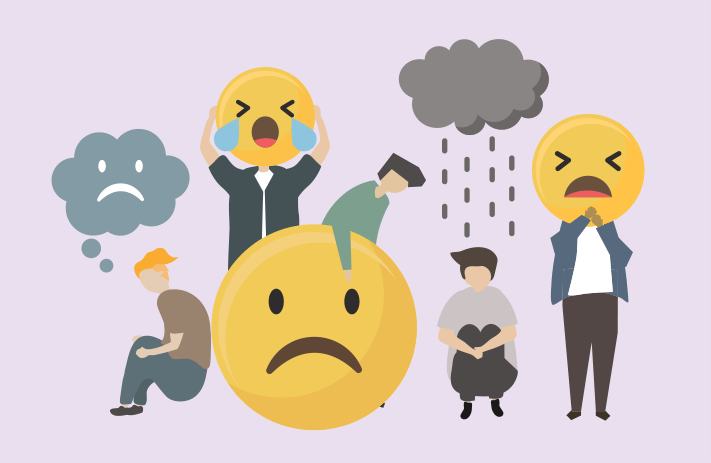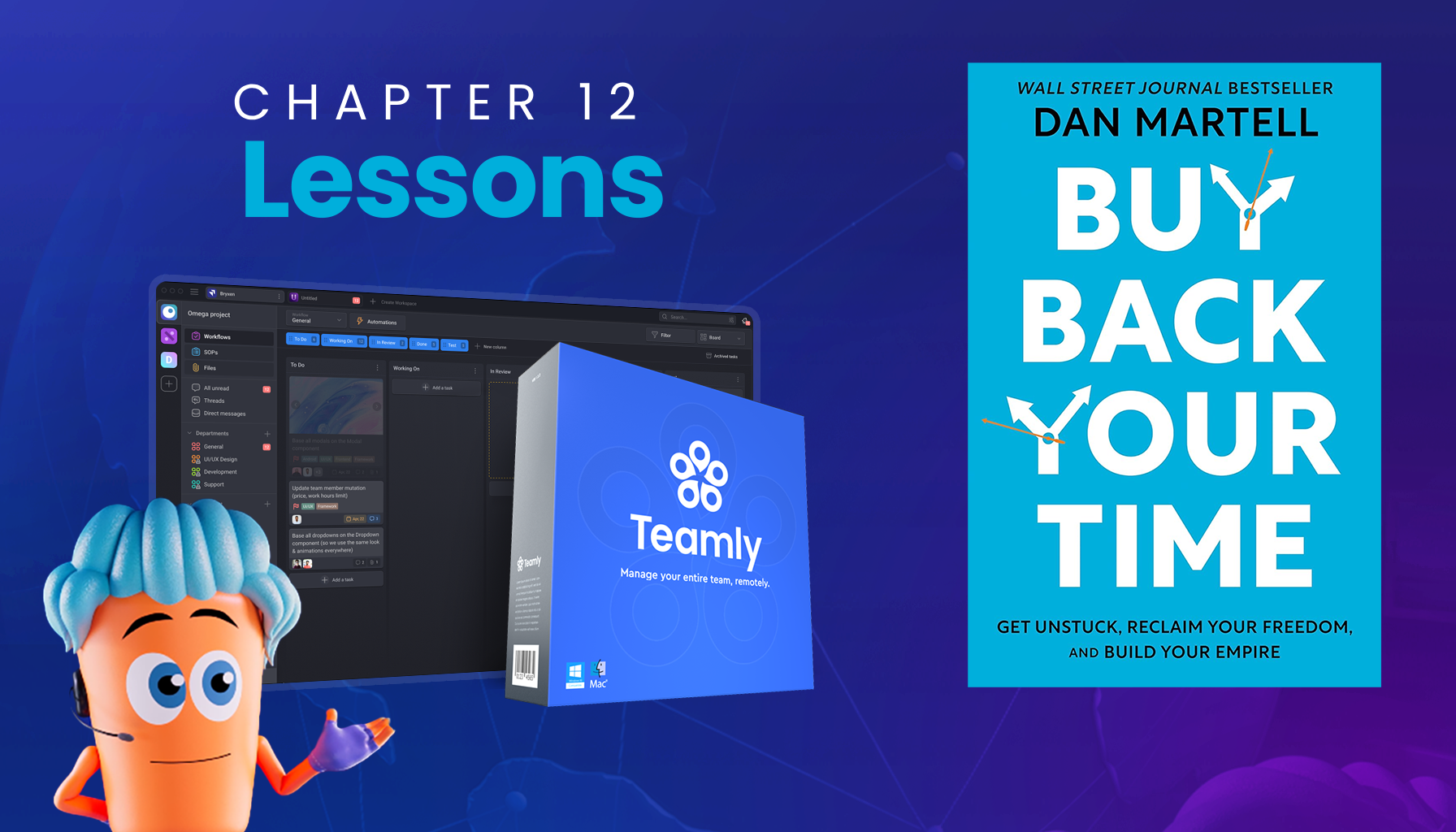
Click the button to start reading
Your Go-To Guide For Team Effectiveness Models: Why Teams Fail & How To Fix Them
Do you ever feel like your team just isn’t working as effectively as it could be?
The inconvenient truth is that most teams are dysfunctional to some degree. And the reason is that team dynamics are complex.
But don’t despair. There’s hope.
There’s a lot of research out there on what makes a team effective – and how to fix them when things go wrong.
In this blog post, we’ll take a detailed look at seven different team effectiveness models and what they can teach us about making teams work better.
So whether you’re hoping to improve your current team’s effectiveness or build an all-star team from scratch, this guide is for you.
Let’s get started!

Team Effectiveness Defined
Before we dive into the different models, it’s important to first understand what we mean when we talk about team effectiveness.
Team effectiveness = “the capacity of a team to consistently produce results.” In other words, an effective team is one that is able to reach its goals and objectives on a consistent basis.
It’s important to note that there are different types of team effectiveness. For example, a team can be effective in the short-term but not the long-term. Or a team can be effective at completing certain types of tasks but not others.
There are many factors that can impact a team’s effectiveness, including team size, team structure, team dynamics, and individual personalities.
But the nuts and bolts of team effectiveness comes down to two things: how well the team works together and how well the team members work individually.
The former has to do with things like communication, collaboration, and trust. The latter has to do with things like skills, knowledge, and experience.
Both are important for a team to be effective. But in our experience, the former is usually more important than the latter.
Now your job as a leader is to find a way to foster both of these things so that your team can be as effective as possible. And that’s where team effectiveness models come in.

The 7 Most Popular Team Effectiveness Models
There are a lot of different models out there, but the five listed below are the most popular.
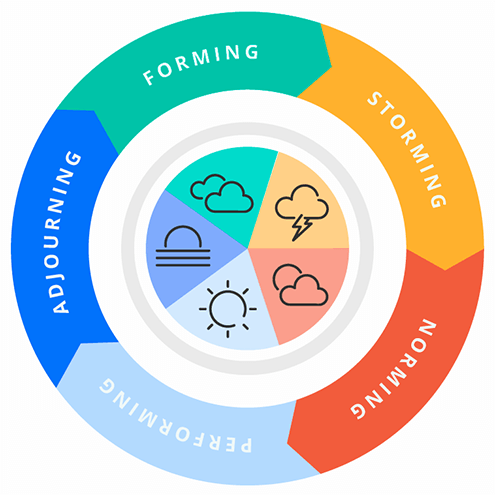
1. The Tuckman Model
The Tuckman model is one of the most widely-used models and was first developed by Bruce Tuckman in 1965.
It’s based on the idea that teams go through four distinct stages of development: forming, storming, norming, and performing.
These four stages are not linear, but rather they occur in cycles as teams ebb and flow between different levels of effectiveness.
Here’s a brief overview of each stage:
- Forming: This is the initial stage of team development where members are getting to know each other and starting to establish norms and expectations.
- Storming: In this stage of team development, conflict starts to emerge as members start to express their own ideas and opinions.
- Norming: This is the third stage of team development where members begin to work together more cohesively and start to resolve conflicts.
- Performing: This is the fourth and final stage of team development where the team is functioning at its highest level and is able to accomplish its goals and objectives.
Challenges Associated with the Tuckman Model
While Tuckman’s model has been widely accepted by researchers and practitioners alike, it does have its share of detractors.
One of the most common criticisms leveled against it is that it doesn’t account for changes in group dynamics over time.
For example, what happens if a new member joins the team during the storming stage? Does the whole process start over again from square one? Or does the new member simply slot into the existing hierarchy?
Another challenge with Tuckman’s model is that it doesn’t address what happens once a team reaches the performing stage.
Once a team has reached peak performance, how can you ensure that they maintain that level of excellence? What steps need to be taken to prevent them from slipping back into old habits? These are important questions that Tuckman’s model fails to address.
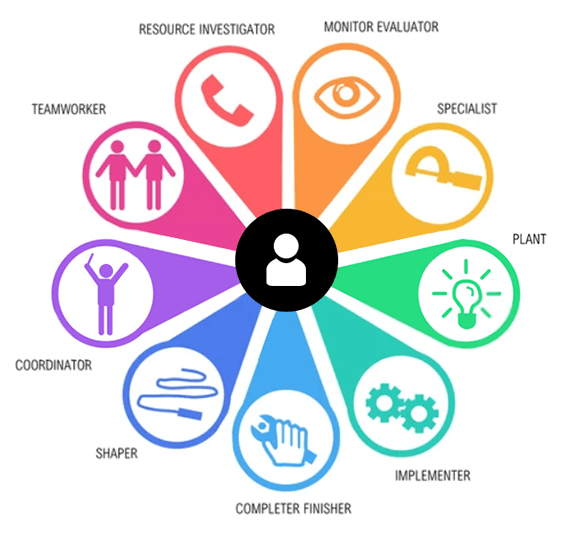
2. The Belbin Model
The Belbin Model is a framework developed by Dr. Meredith Belbin in 1981. It is based on the belief that successful teams are composed of individuals with complementary skills and strengths.
The model divides these strengths into nine different categories, or “roles.”
These roles are as follows:
- Plant: Creative and imaginative; good at generating new ideas.
- Resource Investigator: Good at exploring opportunities and identifying new avenues for the team to pursue.
- Coordinator: Good at organizing people and resources; able to see the big picture.
- Shaper: Challenging and driven; good at pushing people to reach their full potential.
- Monitor-Evaluator: Analytical and objective; good at making sound decisions based on data.
- Team Worker: supportive and good at building relationships; mediates conflict well.
- Implementer: Pragmatic and disciplined; good at seeing projects through from start to finish.
- Completer Finisher: Perfectionistic and detail-oriented; ensures that all loose ends are tied up before moving on to the next task.
- Specialist: An expert in their field; brings valuable insights and knowledge to the team.
How Can the Belbin Model Be Used?
The Belbin Model can be used in a number of ways, but its primary purpose is to help businesses identify an individual’s strengths and weaknesses so that they can be placed on teams where they will thrive.
To do this, businesses first need to administer a series of tests (known as “Belbin Profiles”) to their employees. These tests measure an individual’s preferences and tendencies in various situations.
Based on the results of these tests, individuals can then be placed into one or more of the nine aforementioned categories.
Once everyone has been placed into a category, businesses can then begin to build teams based on complementary skillsets.
For example, if you have a team full of shapers but no monitors, you may want to consider adding a monitor to help balance things out. The goal is to create a team where each member has strengths that complement the weaknesses of others. By doing this, you can optimize both individual and team performance.
In addition to helping businesses build effective teams, the Belbin Model can also be used to assess an individual’s training needs and development goals.
By understanding an individual’s strengths and weaknesses, businesses can provide them with targeted training that will help them grow in their role and contribute more effectively to their team.
The Belbin Model can also be used to resolve conflict within teams. By understanding an individual’s natural tendencies and preferences, team members can learn to accommodate one another’s strengths and weaknesses, thereby reducing friction and increasing harmony.
Overall, the Belbin Model is a valuable tool that can be used in a variety of ways to improve team performance. If you’re looking to build an effective team, or if you’re interested in learning more about your own strengths and weaknesses, consider administering the Belbin Profile to yourself and your employees.
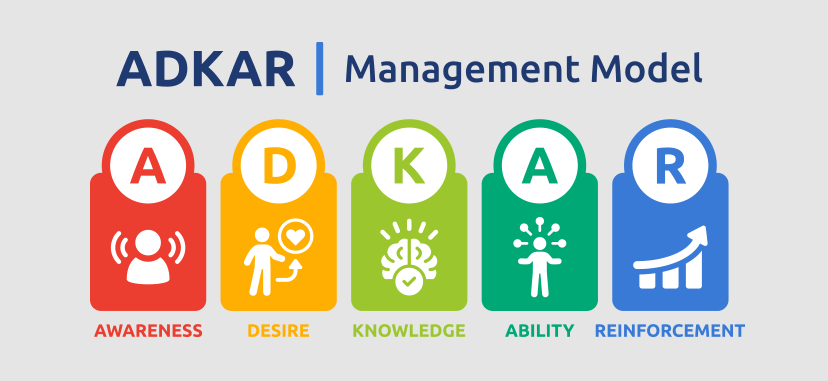
3. The Prosci ADKAR Model
The Prosci ADKAR Model is a tool that can be used to help individuals and organizations transform. Developed by Jeff Hiatt, the model is based on the belief that change occurs one person at a time.
It’s based on the premise that team effectiveness is achieved by aligning the behaviors of individual team members with the desired outcomes of the team as a whole.
The acronym “ADKAR” stands for the following five stages of change: Awareness, Desire, Knowledge, Ability, and Reinforcement.
- The Awareness phase is all about understanding what the team is trying to achieve and why it’s important. This phase is essential for buy-in from all team members. If everyone isn’t on board with the mission of the team, then it’s going to be tough to achieve anything meaningful.
- The Desire phase is about motivation. Each team member needs to be internally motivated to change their behavior and align it with the desired outcomes of the team. Simply put, they need to want to make things better.
- The Knowledge phase is about understanding how to change their behavior to meet the goals of the team. This might involve learning new skills or changing long-standing habits. In any case, it’s essential that everyone knows exactly what they need to do differently and why it’s important.
- The Ability phase is about putting those newly learned skills into practice and making them part of each team member’s repertoire. This takes time and effort, but eventually, with enough practice, it will become second nature.
Finally, there’s the Reinforcement phase. This is where each team member commits to continuing these new behaviors even when things are tough or stressful. It’s easy to fall back into old habits when times get tough, but if everyone can stick with it, then lasting change will occur.
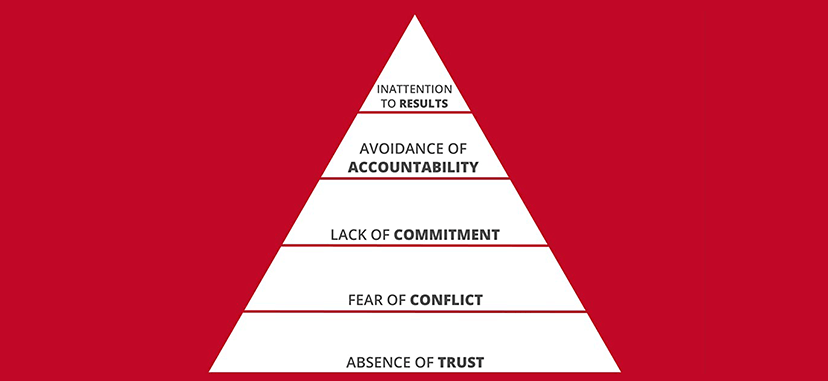
4. The Lencioni Model
Lencioni’s model is based on the premise that there are five primary dysfunctions that can prevent a team from being effective:
- Absence of trust: Without trust, team members will be unwilling to be vulnerable with one another and share their true thoughts and feelings. This lack of vulnerability will inhibit collaboration and make it difficult for the team to reach its full potential.
- Fear of conflict: If team members are afraid to disagree with one another, they’ll avoid healthy debate and constructive criticism. This will lead to suboptimal decision-making and limit the team’s creativity.
- Lack of commitment: Without buy-in from all team members, it’ll be difficult to move forward with decisiveness and unity of purpose. This can lead to fragmentation and factionalism within the team.
- Inattention to results: If team members focus too narrowly on their own individual goals, they’ll lose sight of the collective goal and become more concerned with winning personal battles than achieving collective success.
- Avoidance of accountability: If team members are not held accountable for their performance, they’ll quickly become complacent and begin coasting through their workdays. This lack of accountability will further erode trust, commitment, and results.
Resolving these dysfunctions requires a commitment from both the leader and the team members to overcome some deeply rooted habits and beliefs. But if you’re able to do so, you’ll find that your team functions at a whole new level.
Here are some tips for putting The Lencioni Model into practice:
- Encourage healthy debate by establishing ground rules for discussion (e.g., no personal attacks, stay focused on the issue at hand).
- Make sure everyone is on the same page by clarifying roles, responsibilities, and expectations upfront.
- Create opportunities for social interaction by organizing regular team-building activities outside of work hours (e.g., happy hours, group outings).
[optional] Keep things fun by infusing humor into your interactions with team members (e .g., self-deprecating jokes, puns).
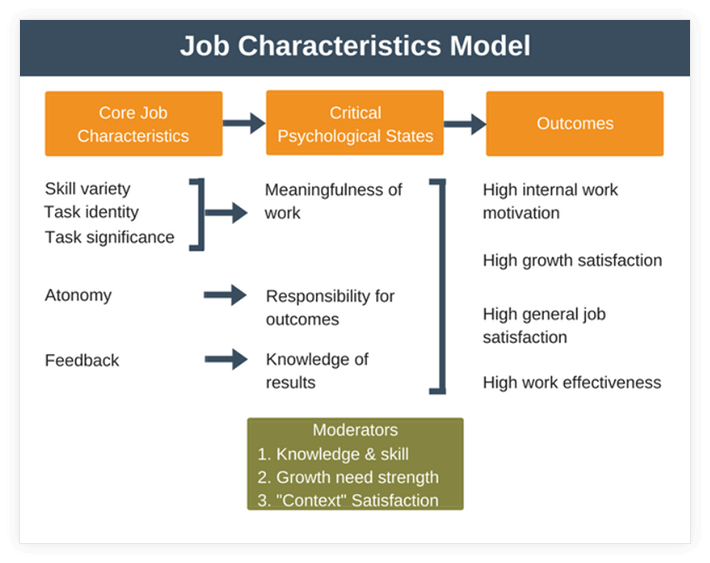
5. The Job Characteristics Model
The Job Characteristics model is a framework for designing jobs that are motivating and satisfying. It was first developed in the 70’s by two researchers named J. Richard Hackman and Greg Oldham.
The model suggests that there are five core job characteristics that impact motivation and satisfaction:
- Task identity: This is how much a job involves completing a whole, identifiable piece of work with a clear beginning and end. Jobs with high task identity are typically more motivating than those with low task identity.
- Task significance: This is the degree to which a job has a positive impact on the lives or work of others. Jobs with high task significance are typically more motivating than those with low task significance.
- Autonomy: is exactly what it sounds like—the degree to which a job provides employees with the freedom to direct their own work. Jobs with high autonomy are typically more motivating than those with low autonomy.
- Feedback: This is the degree to which employees receive clear and timely information about the results of their work. Jobs with high feedback are typically more motivating than those with low feedback.
- Task variety: This is the degree to which a job consists of a variety of activities. Jobs with high task variety are typically more motivating than those with low task variety.
The Job Characteristics model has been found to be a powerful predictor of job satisfaction and motivation. In fact, a meta-analysis of over 100 studies found that the model accounted for over 20% of the variance in job satisfaction.
So, if you’re looking to create a more motivating and satisfying job for yourself or for your team members, this is a great place to start.
Here are some tips for putting The Job Characteristics model into practice:
- Make sure tasks are well-defined and have a clear beginning and end.
- Make sure tasks are significant and have a positive impact on others.
- Give employees autonomy over their work.
- Provide clear and timely feedback on results.
- Make sure tasks are varied and interesting.

6. The Google Model
Google conducted a study where they observed over 180 different teams in an attempt to identify the key factors that make a team successful. They found that there are five key dynamics that separates the best teams from the rest:
- Psychological safety: This is the degree to which team members feel safe to take risks and be vulnerable with one another.
- Dependability: This is the degree to which team members can count on one another to do their fair share of the work and to meet deadlines.
- Structure and clarity: This is the degree to which team members have a clear understanding of their roles, responsibilities, and goals.
- Meaning: This is the degree to which team members believe their work is important and relevant to their lives.
- Impact: This is the degree to which team members believe their work is making a positive impact on the world.
The Google study found that psychological safety was the most important factor in predicting team success. In fact, teams with high levels of psychological safety were found to be significantly more effective than those with low levels of psychological safety.
So, if you want to create a successful team, make sure to focus on creating a safe environment where team members feel comfortable taking risks and being vulnerable with one another.
Here are some tips for creating a psychologically safe environment:
- Encourage open communication and dialogue.
- Encourage team members to take risks and experiment.
- Encourage team members to give and receive feedback openly.
- Encourage team members to challenge the status quo.
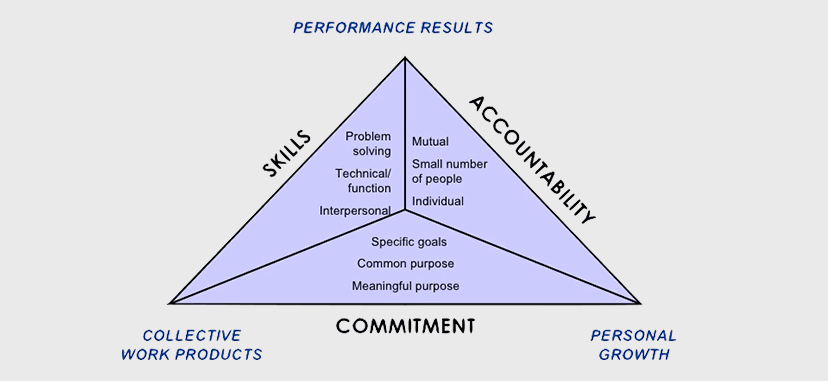
7. The Katzenbach and Smith Model
In their book, The Wisdom of Teams, Jon Katzenbach and Douglas Smith lay out their model of efficient teams in a triangular diagram. The three points represent the larger deliverables of any team: collective work products, performance results, and personal growth.
To reach peak efficiency, a team must achieve all three of these objectives. However, most teams only focus on one or two, leading to sub-optimal results.
For example, many teams focus solely on collective work products and disregard personal growth. This can lead to a feeling of stagnation and eventually lead to team members becoming disengaged and leaving the team.
Other teams focus solely on performance results and fail to produce any collective work products. This can lead to a feeling of individualism and competition, rather than cooperation and teamwork.
The best teams are those that balance all three objectives. By doing so, they are able to produce great results while also providing opportunities for personal growth.
There are 3 essential qualities to the Katzenbach and Smith model:
- Commitment: The team must be committed to all three objectives: collective work products, performance results, and personal growth.
- Accountability: The team must be accountable to each other and to the organization for all three objectives.
- Skillset: The team must have the necessary skillset to achieve all three objectives.
If you want to create a successful team, make sure to focus on all three objectives: collective work products, performance results, and personal growth. By doing so, you will create a team that is balanced and able to achieve great things.
Summary
So, what have we learned?
Teams can be incredibly effective when they are working towards a common goal and have the right tools. But teams can also go wrong very quickly.
That’s where models come in .
Now, models are just that: models. They are not perfect and they will never be able to explain everything about team effectiveness. But they can give us a framework to understand how teams work and what factors contribute to their success or failure.
We’ve looked at seven different models of team effectiveness: The Tuckman Model, The Belbin Model, The Prosci ADKAR Model, The Lencioni Model, The Job Characteristics model, The Google Model, and the Katzenbach and Smith Model.
Each of these models has something unique to offer and can help us understand team effectiveness in a different way.
So, which model is the best?
The answer is: it depends.
It depends on your team, your goals, and your specific situation.
The perfect solution is to take what works from each model and create a custom solution that fits your team’s needs.
By doing so, you will create a team that is balanced, efficient, and effective.
And that’s the goal, after all.

